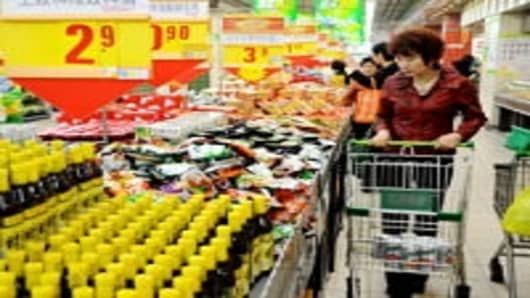The onward march of the Chinese consumer continues, with China overtaking the U.S. as the biggest grocery market in the world in 2011, according to new research out of the United Kingdom.
The Chinese grocery sector was worth $970 billion (607 billion pounds) at the end of 2011, while the U.S. market came in at $913.5 billion (572 billion pounds), research by food industry analysts IGD showed.
The figures come at a time of widespread food price inflationas well as rapid economic growth in China, which is now the world’s second-largest economy as well as the most populous country. The analysts believe the gap between spending by Chinese and American consumers on groceries will widen over the next few years, with the market for groceries in China reaching 918 billion pounds by 2015.
The leap has been driven by food price inflation as well as economic growth, as soft commodities such as wheat surged in response to increased demand from China and other emerging markets. The Chinese are moving from a diet based around rice and pork to embrace dairy products, wheat, grains, white and red meat, which has helped boost prices around the world.
The four BRIC countries— Brazil, Russia, India and China — are expected to make up four of the top five grocery markets by 2015.
The forecasts take into account a “significant slowing” of China’s rapid economic growth. Worries about worse-than-expected growth in China’s gross domestic product , which the Chinese government predicts will expand by 7.5 percent in 2012, down from 9.2 percent last year, have come onto the markets’ agenda again.
Wages should continue to grow faster than inflation, as the Chinese government has tried to dampen inflation at the expense of slowing growth.
“Despite the slowdown, measures to stimulate Chinese domestic consumption present an opportunity for retailers. For example, higher wages could boost disposable income and increase the number of potential customers,” Cécile Riverain, IGD’s international research manager, told CNBC.com.
Consumer goods giants like Unilever and Procter & Gamble have been able to push through double-digit price rises and still maintain volume growth in China, while price increases have hit their volume growth in Western markets, according to Rahul Sharma, retail analyst at Neev Capital.
“There’s actually much more pricing power in Asia than in the West,” he told CNBC.com. “Consumers are maturing and buying more brands, but it’s not the usual suspects that are doing well.”
He added that Western brands are generally well-trusted in China, which has seen a number of food safety scandals in recent years.
Western fast food retailers can also benefit from the increased number of Chinese people eating out, according to Sharma. Kentucky Fried Chicken has a much bigger presence in China than fast food rival McDonalds .
Global retailers like Walmart , Tesco and Carrefour are trying to capitalize on the burgeoning Chinese consumer, with mixed results so far.
Chinese consumers, many of whom are used to shopping in “wet markets” — traditional fresh food markets — want to have fresh food and are still extremely price-conscious, according to Sharma.
“It’s actually the local retailers who are doing best,” he said. “There’s a big focus on price and retailers have to convince Chinese consumers that they’re not too expensive.”
International chains will open close to 2,700 stores in China over the next four years, according to IGD.
“There are significant hurdles to overcome, not least the often slow and arduous legal process, but securing return on investment is the most challenging piece of the jigsaw for global retailers,” Riverain said.



